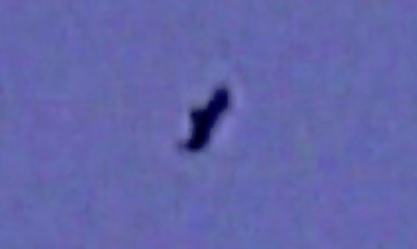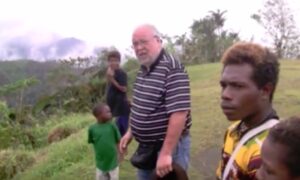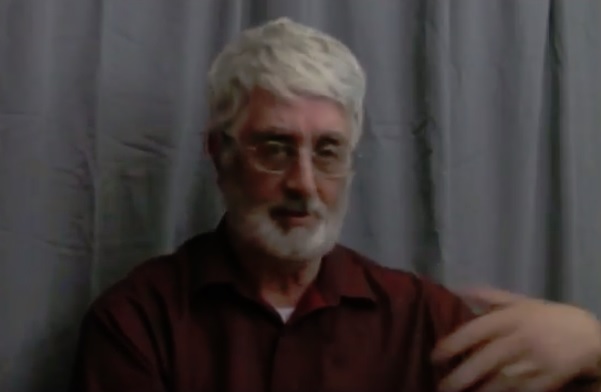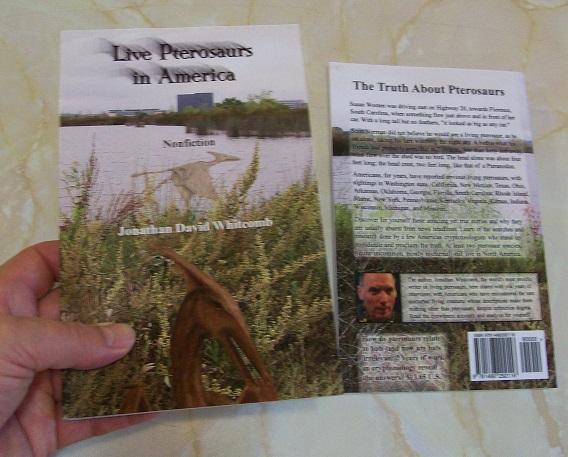By an expert in living pterosaurs: Jonathan Whitcomb
The other day, I found a Youtube video about an expedition in Papua New Guinea in 2015, a search for a modern pterosaur on the island of New Britain. What a success it was!
Milt Marcy and Peter Beach, two cryptozoologists from the Portland area of Oregon, witnessed the large flying creature in clear daylight on March 25, 2015. I was aware of their expedition, for I spoke with both of them, by phone, soon after they returned to the United States.
American explorer Milt Marcy on New Britain Island, PNG, in 2015
Why did I delay reporting, on this blog, their success? Because of a prior agreement that I had made, a number of years before the expedition in 2015, with another cryptozoologist: I had agreed to keep the location secret, as well as the names of three eyewitnesses in earlier sightings. Now that a documentary has been produced about this expedition, I can reveal much more.
Quoting from the book Searching for Ropens and Finding God
. . . ten sightings by these eyewitnesses were from 1989-1991, all in the same area. All saw a bill or beak-like mouth; none mentioned feathers. Two saw nothing like a tail . . . [Apparently this species of modern pterosaur has either a short tail or practically none at all.] Each time, the creature or creatures flew in bright sunlight, all but one sighting being of two or three gliding single file . . .
The names of those three American eyewitnesses have now been revealed in this Youtube video:
- Harriet Sconce
- Steve Sconce
- Marvin Sconce
How does the expedition in 2015 relate to ten earlier sightings?
Milt Marcy and Peter Beach had been on a number of cryptozoology expeditions before they accompanied Steve Sconce to New Britain Island in Papua New Guinea (PNG). They knew of the sightings by members of the Sconce family, encounters with what appeared to be modern pterosaurs that would sometimes fly over a remote village in daylight. Marcy and Beach hoped to see one of the potential modern pterosaurs themselves.
They were rewarded with a sighting that lasted at least two minutes or so, on March 25, 2018. Beach was able to videotape the flying creature, but he is not a wildlife photographer: The footage was obtained when he was unable to point the camera precisely, and the apparent pterosaur was recorded in zoomed-out lens mode.
In other words, the video footage was a poor-quality recording of the flying creature. Take this in context. When Beach heard the shouting of the people outside (including “Big bird!”), he was resting indoors, suffering with pneumonia. When he got outside, he tried to point the camera towards the apparent pterosaur, but there was no eyepiece on that camera. There was no way that he could have zoomed in on it when he did not even know if the camera was pointed exactly towards the potential pterosaur.
The other camera, which was of better quality, had been placed in a different location than usual, and in the rush to look up and see what was overhead Marcy did not realize that he could have grabbed that camera before searching the sky.
By the way, this sighting was in daylight, as were the sightings by members of the Sconce family years earlier in this same area.

still image from video obtain on March 25, 2015, in PNG
Peter Beach, a biologist, saw that this flying creature differed from an eagle and from a vulture. He also noted a number of things that set it apart from a frigate bird (this is sometimes spelled as two words: frigate bird). Both Beach and Marcy noted what appeared to be claws or a hand-like structure on the leading edge of each wing. This flying creature was much bigger than a flying fox fruit bat, with a wingspan that Beach estimated to be twelve feet.
Important to the cryptozoological investigation, the flying creature observed by Beach and Marcy had little or no tail, like those seen by members of the Sconce family many years earlier in that same area of New Britain Island. That means that although this kind of animal appears to be a pterosaur, it is not the same type that is known on Umboi Island, for the ropen of Umboi has a very long tail.
Biologist Peter Beach in an interview for the documentary
###
.
Living pterosaurs in Washington state
I had been standing alongside the river on our property out in Randle – Washington like I usually do . . . it was some time around midnight, when it started getting truly dark that night. I had been staring down toward the end of my view of the river, thinking my eyes were playing tricks on me, because down around the bend of the river where I couldn’t see very well, [it] was being lit up by this eerie looking dim red glow . . .
.
Pterosaur expedition in Papua New Guinea
At last, after eleven expeditions in 21 years, we have a ground-breaking success: Both Americans saw, in daylight, a huge apparent living pterosaur.
.
Non-extinct pterosaurs in Papua New Guinea
During Jonathan Whitcomb’s expedition in Papua New Guinea, in 2004, he interviewed Gideon Koro, who was one of seven boys who encountered the ropen, as it flew over a crater lake on Umboi Island.
.
Living pterosaurs in southwest Pacific
A list of nonfiction books about modern pterosaurs
.
The following persons ask the general public to become aware of research into many eyewitness sightings of apparent extant pterosaurs, commonly called “pterodactyls,” and to consider the possibility that at least some of the accounts have been from actual encounters with flying creatures descended from animals closely related to pterosaurs known from fossils.
.
Pterodactyloid vs ropen in Papua New Guinea
That brings us to another point that can make some paleontologists uncomfortable. Not all sightings of modern pterosaurs suggest something like a Rhamphorhynchoid type, although the long-tailed ones outnumber those that suggest Pterodactyloid kinds. Yes, shocking as it may be, modern “basal” pterosaurs appear to outnumber those that seem to be Pterodactyloid types, and the ration may be more than 4-to-1, perhaps even as great as 20-to-1.
.
________________________________________________________________________
Live Pterosaurs in America (nonfiction by Jonathan David Whitcomb)
From the title page of this nonfiction book:
How are sightings in the United States related to those in the southwest Pacific? . . . How could modern living pterosaurs have escaped scientific notice? These mysteries have slept in the dark, beyond the knowledge of almost all Americans, even beyond our wildest dreams . . . These mysteries have slept . . . until now.





